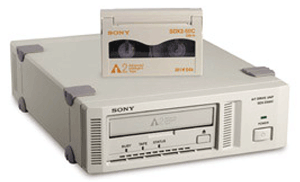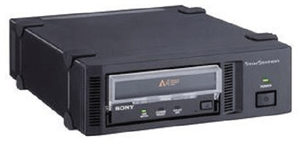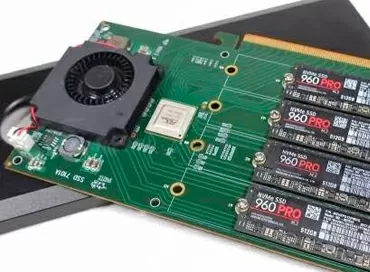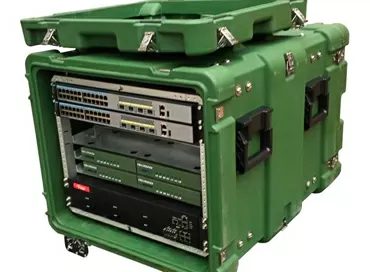AIT (Advanced Intelligent Tape) tape drives from Sony
The AIT format was developed by Sony based on helican-scan technology. It was the first to use built-in flash memory on a MIC (Memory-In-Cassette) cassette, which contains service information about the tape content and a data distribution map, which allows to optimize access to them. Like other modern formats, AIT uses a tracking system (ATF) to record tracks more densely.
AIT Features:
- Specially designed drive cooling mechanism, blowing air from tape drive mechanisms and read-write heads.
- MIC (Memory in cassette) A rewritable chip on a media used to store information about the contents of a tape. The consequence of the introduction of this technology is an increase in reliability and, most importantly, the average time of access to files has decreased by almost 2 times.
- Active Head Cleaner is a built-in mechanism for cleaning the drive heads, which is activated by the device when a large number of errors occur while working with the tape. Thus, the cleaning tape is not required after a given number of passes, but exactly when it is needed.
- AME (Advanced Metal Evaporated) The use of AME tape with vacuum deposition of 100% cobalt, allows you to get 2 nd higher recording density than conventional (MP) tape. At the same time, the tape itself is much less exposed to wear, due to the coating of diamond-like carbon, and the head of the device is practically not clogged, since it does not come into direct contact with the magnetic layer.
- Compression algorithm to achieve 2.6: 1 compression
AIT Devices
The first AIT-1 devices appeared in 1996 and allowed to save up to 25 GB of information per cartridge at a write speed of 3 Mb/s (when using hardware compression, these values are 50 GB and 6 Mb/s, respectively).

First generation device AIT-1
The capacity was subsequently increased to 35 GB (91 GB compressed) thanks to the new generation of cartridges. The Sony AIT-1 drives were very reliable. Thanks to the Super Head Cleaner mechanism, the need for periodic head cleaning was eliminated and the MTBF at 100% load reached 200,000 hours. Problems such as high temperature and pollution were also resolved. The internal cleaning mechanism of the heads automatically cleans and cools them, and the built-in data protection system prevents accidental erasure of data and premature wear of the tape.

Second generation device AIT-2
Second-generation drives AIT-2, which appeared a year later, allowed to store up to 50 GB (100 GB - with compression) of information, while the compressed data transfer rate was 6 (12) Mb/s.
Both in the AIT-2 devices and in the third generation AIT-3 devices that followed them, Sony was able to achieve higher reliability, which opened the way for these drives to the corporate environment. Used in cartridges, the AIT-1LC magnetic tape has provided increased storage capacity in entry-level devices, where the market has a strong demand for systems with a low unit storage cost. AIT-3 tapes can store up to 100GB (or 200GB compressed) of data, double the capacity of AIT-2. Larger cartridges can store up to 260GB of data.
In AIT-3 magnetic tape drives, data in its original form is transmitted at a speed of 12 Mbit/s or 24 Mbit/s in compressed form. Like the AIT-2 devices, each cartridge is equipped with a MIC (Memory-in-Cassette) remote control chip, but at the same time a new type of 64-bit crystal is used, which allows storing more information. It contains, in particular, a log file with information about the feed, a search card and other data at the discretion of the user.

Fourth generation device AIT-4
In 2005, Sony released the latest generation of AIT drives - the 4th generation AIT-4 tape drive. AIT-4 cartridges can hold 200 GB of information, which is twice the capacity of the previous AIT-3 cartridge. The new cartridge has increased the tape length and uses a technology of denser data recording on tape: the AIT-3 had a recording density of 720 Mbit/inch2, and the AIT-4 had 1170 Mbit/inch 2 .
Thanks to the 2.6: 1 compression algorithm, the AIT-4 cartridge can hold up to 520 GB of compressed data, at a write speed of 62.4 MB/s, which is also double that of the AIT-3. This significant increase in capacity and speed has been achieved by increasing the speed of the drum with read/write heads, as well as by improving the design of the heads themselves. AIT-4 is fully compatible with all three generations of drives, which ensures a painless transition to a new recording format when upgrading the hardware complex.
AIT-1 Turbo/AIT-2 Turbo
Sony was one of the first tape drive companies to add Serial Advanced Technology Architecture (SATA) support to its devices. These drives were marketed as AIT-1 Turbo and AIT-2 Turbo.
AIT-2 Turbo can store up to 80 GB (208 GB - when using 2.6: 1 compression), providing a data transfer rate of 12 MB/s. The AIT-1 Turbo drive delivers twice the modest performance: 40 GB (104 GB compressed) and 6 MB/s, respectively. In addition, the AIT-2 Turbo is compatible with WORM (Write Once/Read Many) technology, a write-once/read-many technology.

Super AIT (S-AIT) - Super Advanced Intelligent Tape
Based on the AIT format, in 2001 Sony specialists developed the S-AIT (Super Advanced Intelligent Tape) format. Unlike AIT (3.5 "), the cassette and disk drive are 5.25". The cassette uses one roller and tape width is 0.5 inches. AIT and S-AIT are made using the same technology, but the capacity of the S-AIT cassette is 5 times larger (500 GB uncompressed) by increasing the total tape area. S-AIT uses all advanced technologies - AME, MIC, Helical Scan, etc. S-AIT also offers high data transfer rates - 30 Mb/s.

S-AIT Tape Drive
The second version of SAIT-2 is next; its capacity will be doubled, up to 1 TB (2.6 TB with compression) at a transfer rate of 60 MB/s (156 MB/s with compression). In each of the next two generations, SAIT-3 and SAIT-4, the characteristics will consistently double.

In other words, for SAIT-3 the capacity will be 2 TB (5.2 TB with compression) at the exchange rate of 120 MB/s (312 MB/s with compression), for SAIT-4 - 4 TB (10.4 TB Compressed).
Review prepared by: D. Zaluzhny, NStor based on Quantum materials , Sony, HP, Certance, OnStream and IBM.
29/05.2006













